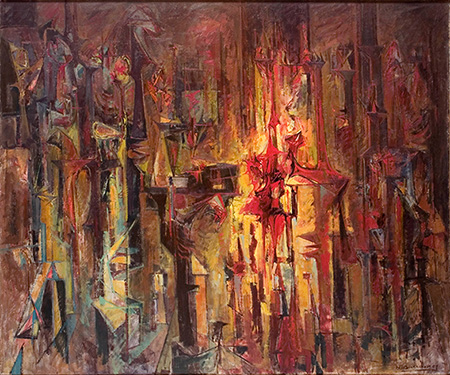
Continuing through December 23, 2017
A Hans Burkhardt survey might seem an unusual choice for a Pacific Standard Time (PST): LA/LA exhibition. Yet the Swiss-born abstract expressionist found a spiritual home in Mexico. Having traveled to Mexico several times, and having lived there for extended periods, the artist infused his work with the country’s colors, sensuality and spiritual qualities. Forty-one of these paintings are included in this show.
The 20-year old Burkhardt moved to New York in 1924, and soon after took classes at Cooper Union to improve his decorative motif painting skills (from which he earned a living). Enrolling there turned out to be fortuitous as he discovered that he had a talent for fine art, and soon began studying with Arshile Gorky. As Burkhardt developed his artistic skills, he imbued his work with strong colors, carefully balanced compositions, and deep emotions.
He relocated to Los Angeles in 1937, where he continued to paint in the abstract style, and became widely known for his New York influenced works. In 1939, Lorser Feitelson promoted Burkhardt's work for national art exhibitions and arranged for his first solo show. Starting in the 1940s, major museums began exhibiting and aquiring his work; these included the L.A. County Museum of Art, the Metropolitan Museum of Art and the British Museum. He taught at UCLA, Otis College of Art and Design and Cal State, Northridge.
The peripatetic Burkhardt first visited Guadalajara in 1950, quickly discovering that his abstract expressionist style contrasted with the Mexican culture, particularly with its indigenous-influenced artwork. Yet he was intrigued by the country, stating, “Everything was old, antique … What can I paint? I decided I had to study their culture … I painted the soul of Mexico.” He immersed himself in the country’s Latin architecture and culture, as well as in its churches, taverns, tropical landscapes and especially in its funeral processions. He empathized with the impoverished peasants, while reflecting on his own difficult childhood in Switzerland.
Employing his well-honed creative skills, Burkhardt began permeating his abstract work with Mexican themes and colors, creating paintings that he referred to as “Burials.” Among these is his 1956 blue-infused “Journey,” with three slender vertical figures, referencing pallbearers carrying coffins. More than depicting a local ritual, the image evokes the passage of souls to another world. Inspired by the sounds of San Miguel or “the city of bells” (where bells seemed to continually ring, “for the one who could no longer hear them,” he said), Burkhardt created “Silent Sounds” (1958) and “Sounds of San Miguel” (1960). The former work is permeated with grays; while the latter’s predominantly blue brushwork express passion and reverence for the spiritual world.
The contrasting 1957 “City at Night (Guadalajara),” with its bold strokes of reds, oranges and yellows, evokes the stained glass windows of the country’s cathedrals. “By the Candle Light” (1950), featuring three child-like figures, was influenced by a scene of three children dining by candlelight that he saw through a window. The energetic “Cockfight” (1956), with its deep reds and browns, captures the fury and passion of the fight. “Old City” (1950) combines figuration with abstraction, while revealing hints of cubism with its fractured objects and geometric forms. Another cubist inspired work is “Self Portrait in a Studio” (1951), depicting the artist in his studio with his palette. His 1953 paintings, “Composition” and “Black Cloud Over Vineyard,” abstract landscapes with red tones, are inspired by his love of nature.
Mexico represented the manifestation of the artist’s sensibilities going back to his earliest years in Switzerland. “Mexico’s contrasts were no greater than the duality that was Hans Burkhardt, a painter of celebration of life,” the gallery’s Director Jack Rutberg said. “But when stung by injustice, his response was astounding, as reflected in his later anti-war paintings.”
Burkhardt became widely esteemed in Mexico. Among his lifelong admirers was Mexican painter Rufino Tamayo. The Instituto Allende in San Miguel gave him solo shows in 1956 and 1960. He was regarded as a “great Mexican master,” alongside Orozco, Rivera and Siqueiros, by art critics of the time.
